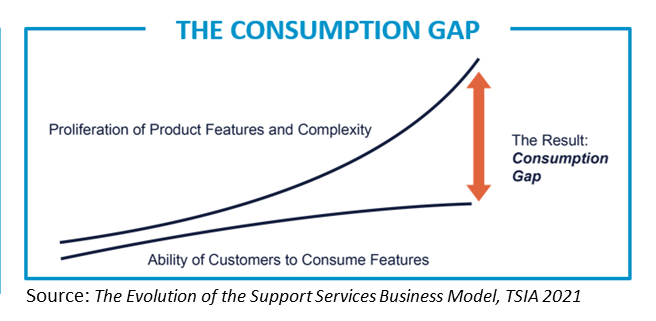If you’re a software-as-a-service (SaaS) customer, you’re already enjoying the many advantages of SaaS: no upfront capital expenditure, nearly limitless scalability, and vendor-provided software management, just to mention a few. But is your SaaS app yielding maximum return on investment (ROI)? Unless you’re tapping the app’s full feature set, it’s not.
With SaaS, major product releases occur at a much faster pace than with on-premises software. SaaS vendors often roll out three or four major releases every year. Compare this to on-premises software, which has a major release every one to two years.
Major releases typically deliver major enhancements. That means you’re gaining new capabilities at a much faster rate than in the past. It also means that you have far less time to absorb those new capabilities. Consequently, your users are presented with new features before they’ve had a chance to consume the ones they already have.

Consequently, the level of consumption of a SaaS app’s feature set is dropping. The result is what the Technology & Services Industry Association (TSIA) calls the consumption gap. Unless you’re leveraging the full power of your SaaS solutions, your organization isn’t deriving the full value from its SaaS investments.
The changing support role
When you implement a SaaS app, you give primary responsibility for support to the SaaS vendor. But SaaS vendors approach support in a completely different way than traditional, on-premises support teams. With on-premises software, the support team’s primary role is break/fix, whereas the primary role of SaaS vendor support teams is to help customers bridge the consumption gap—driving up adoption and increasing ROI.
To achieve this objective, SaaS vendors have disrupted the traditional support model by changing its focus to make it more consultative and more customer centric. They are applying best practices and innovation to attain the level of support their customers demand.
Rising to the occasion
Software support has evolved over the years, becoming increasingly proactive and personalized. There are essentially five stages in this evolution, with each stage delivering an improved level of support.
- Stage 1— Reactive. The support team waits for a customer to report a problem and then works with the customer to resolve it. Customers often become frustrated with reactive support because they typically have to wait for a response. Hence, problem resolution time may stretch out, dragging down productivity. Reactive support isn’t acceptable in the SaaS world.
- Stage 2—Self-help. The support team provides tools that empower customers to resolve many issues on their own. Examples include knowledgebases and FAQs that users can search to find resolutions to known problems. Chatbots can also assist users in handling routine issues. Self-help is a huge plus, but it is still a reactive approach.
- Stage 3—Proactive. Proactive mechanisms alert the support team to issues before customers become aware of them. The team resolves the issues and advises the customers of the fixes that have already been made. For example, the team receives an alert that disk space is running low and allocates more disk space so that customers aren’t disrupted. Proactive support leverages performance-monitoring tools that spot issues and, where possible, automatically trigger the appropriate fixes.
- Stage 4—Predictive. The support team leverages intelligence gleaned from telemetry and usage data to spot opportunities to proactively reach out to the customer to offer assistance. For example, take a customer who has acquired a SaaS-based IT service management (ITSM) solution that includes a chatbot feature. Telemetry detects and reports that a customer has just enabled the chatbot feature for the first time. The support team acts immediately, offering to help the customer launch the chatbot by:
- Providing informative articles, YouTube videos, and other resources aimed at making early chatbot efforts more successful
- Apprising customers of the vendor’s professional services, which are available to help identify use cases, speed chatbot technology implementation, and optimize chatbot processes to improve ROI
- Stage 5—Prescriptive. In this highest level of support, the support team gains insight into how customers are using the product. The team leverages that insight to proactively prescribe ways that the customer can more fully exploit product features and functionality. As in the predictive example, the customer has acquired a SaaS-based ITSM solution that includes a chatbot feature. In this case, the customer has not yet enabled the chatbot. The SaaS support team uses telemetry to observe that the customer’s service desk is processing hundreds of identical tickets each month for an issue that has a known workaround. The vendor reaches out to the customer, prescribing how to use the chatbot feature to guide users in implementing the workaround on their own, without involving the service desk. The chatbot simplifies and speeds resolution so that users return to productivity more quickly. In addition, it reduces the workload on the customer’s service desk.
Asking the right questions
Different SaaS vendors are at different stages in their support evolution. That’s why it’s important to evaluate the level of support a SaaS vendor is capable of delivering. The higher the level, the more value the vendor can help you gain from your SaaS solution. While you’re at it, look at your internal IT support organization and make sure it’s positioned to work effectively with the SaaS support team, now and into the future.
Be sure to set realistic expectations. Vendors may not necessarily be able to deliver prescriptive support today, but they should be moving in that direction. At a minimum, they need to be at a proactive level. Don’t, however, lose sight of the prescriptive level. It’s the ultimate level of support due to its highly personalized nature, and the gold standard for where forward-thinking SaaS vendors are going.
If you need assistance with your transition to SaaS, please fill out our form and a BMC Customer Success expert will reach out to get started.
These postings are my own and do not necessarily represent BMC's position, strategies, or opinion.
See an error or have a suggestion? Please let us know by emailing blogs@bmc.com.






